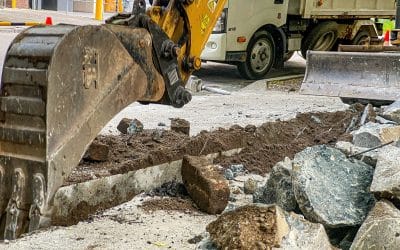Horizontal Directional Drilling (HDD) describes the trenchless method of installing underground infrastructures without disturbing the surface.
Pre-project planning ensures we are aware of all pre-existing underground services.
Global Utility Construction is a horizontal directional drilling expert.
Our HDD crews use cable locators to locate and identify the existing underground infrastructure and locate any services not outlined in any plans.
GUC has modern equipment and experienced drillers to ensure that drills are guided to the desired location.
Infrastructures include
- Telecommunications
- Power cable conduits
- Water
- Gas
What makes a horizontal directional drilling “Directional”?
The ability to steer the head of the drill along great distances is what sets the HDD apart from any other machine.
Operators can start drilling at one point, and monitor and adjust depth and alignment over the entire bore, generally up to 140mts. The bore can be much longer depending on the power of the machine and the number of drilling rods utilised.
How a horizontal directional drill works
The head of the drill has three primary purposes, they are;
- Cut a hole for the rods to pass through and eventually the pipe.
- To steer the bore. Steering the bore is achieved by the shape of the head (see pic); contrary to what you might think, the drill rods and head are not continually turning and cutting. For a straight drill, the rod spins, cutting an even amount of ground from all angles; as the head cuts, the rods are pushed in behind. For directional steering, the drill head is specifically positioned so that when thrust is applied, the shape of the head determines progression in that direction. The beacon transmits a signal to the steerer on the surface holding the receiver.
To house the sonde/transmitter. The transmitter tells the steerer the head’s current depth and front and rear position of the head (giving the direction) and lists the pitch. (The pitch is the percentage the rod is predicted to rise (+) or fall (-) over the course of installing a rod on flat ground. Given that each rod is 3m, if the pitch reads +10, a rod is predicted to reduce in cover by 300mm over the next 3mts.) The receiver also shows the drill head as a clock face, enabling the steerer to know which point the head is in its rotation. For example, if the clockface reads 12, the head is in position to be pushed up; if it is at 3, it is in position to be pushed to the right.
Benefits of Horizontal Directional Drilling (HDD)
1. HDD is cost-efficient. HDD will minimise restoration costs, including trench or concrete/bitumen reinstatement. HDD operates through all underground matter, including hard rock, thus eliminating the need for costly heavy equipment.
2. HDD is time efficient. Compared with trenching, HDD can install pipe in minimal time, especially over long distances. Each shot can achieve a minimum of 20 meters and up to 200 meters. Lower installation times can improve your project schedule.
3. Compared with trenching, HDD is an Environmentally conscious civil works process. There are minimal surface disturbances with only two pilot holes compared with ordinary trenching.
4. To the public eye, there is less impact.
5. HDD simplifies installation in areas with limited access.
- Under buildings
- Roads
- Railway tracks
- Hills
- Waterways
- Congested areas
- Environmentally sensitive areas
6. HDD will minimise project Life cycle costs that stem from surface slumping and reinstatement to backfill trenches.
7. Less disruption to traffic and pedestrians in congested areas and no need to close roads. Please get in touch with us for information on Horizontal Direction Drilling or our Turn-Key Communication infrastructure services.




0 Comments